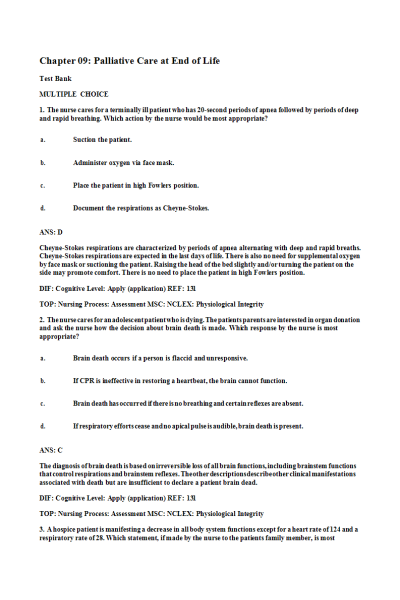Chapter 09 Palliative Care at End of Life: 10 Edition
-
$10.00
| Term | 10 Edition |
| Institution | Tes-Bank |
| Contributor | Exam Practice |
Chapter 09: Palliative Care at End of Life
Multiple Choice
- Question: The nurse cares for a terminally ill patient who has 20-second periods of apnea followed by periods of deep and rapid breathing. Which action by the nurse would be most appropriate?
- Question: The nurse cares for an adolescent patient who is dying. The patients parents are interested in organ donation and ask the nurse how the decision about brain death is made. Which response by the nurse is most appropriate?
- Question: A hospice patient is manifesting a decrease in all body system functions except for a heart rate of 124 and a respiratory rate of 28. Which statement, if made by the nurse to the patients family member, is most appropriate?
- Question: A patient who has been diagnosed with inoperable lung cancer and has a poor prognosis plans a trip across the country to settle some issues with sisters and brothers. The nurse recognizes that the patient is manifesting which psychosocial response to death?
- Question: The spouse of a patient with terminal cancer visits daily and cheerfully talks with the patient about wedding anniversary plans for the next year. When the nurse asks about any concerns, the spouse says, Im busy at work, but otherwise things are fine. Which nursing diagnosis is most appropriate?
- Question: As the nurse admits a patient in end-stage kidney disease to the hospital, the patient tells the nurse, If my heart or breathing stop, I do not want to be resuscitated. Which action is best for the nurse to take?
- Question: A young adult patient with metastatic cancer, who is very close to death, appears restless. The patient keeps repeating, I am not ready to die. Which action is best for the nurse to take?
- Question: The nurse cares for a terminally ill patient who is experiencing pain that is continuous and severe. How should the nurse schedule the administration of opioid pain medications?
- Question: The nurse cares for a patient with lung cancer in a home hospice program. Which action by the nurse ismost appropriate?
- Question: A hospice nurse who has become close to a terminally ill patient is present in the home when the patient dies and feels saddened and tearful as the family members begin to cry. Which action should the nurse take at this time?
- Question: A middle-aged patient tells the nurse, My mother died 4 months ago, and I just cant seem to get over it. Im not sure it is normal to still think about her every day. Which nursing diagnosis is most appropriate?
- Question: The son of a dying patient tells the nurse, Mother doesnt really respond any more when I visit. I dont think she knows that I am here. Which response by the nurse is appropriate?
- Question: Which patient should the nurse refer for hospice care?
- Question: The nurse admits a terminally ill patient to the hospital. What is the first action that the nurse should complete when planning this patients care?
- Question: Which action is best for the nurse to take to ensure culturally competent care for an alert, terminally ill Filipino patient?
| Instituition / Term | |
| Term | 10 Edition |
| Institution | Tes-Bank |
| Contributor | Exam Practice |










